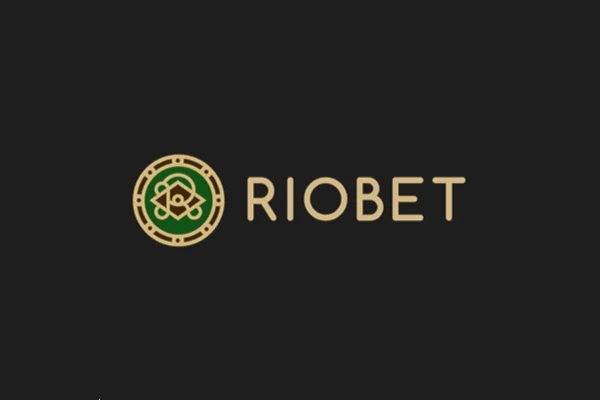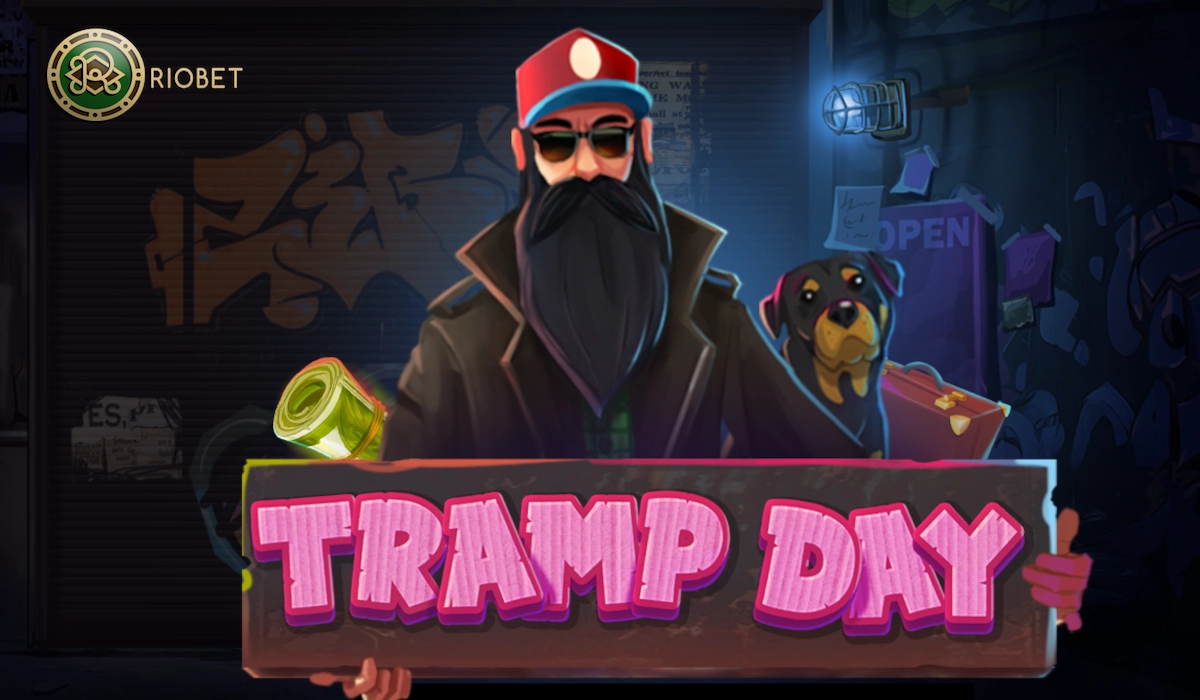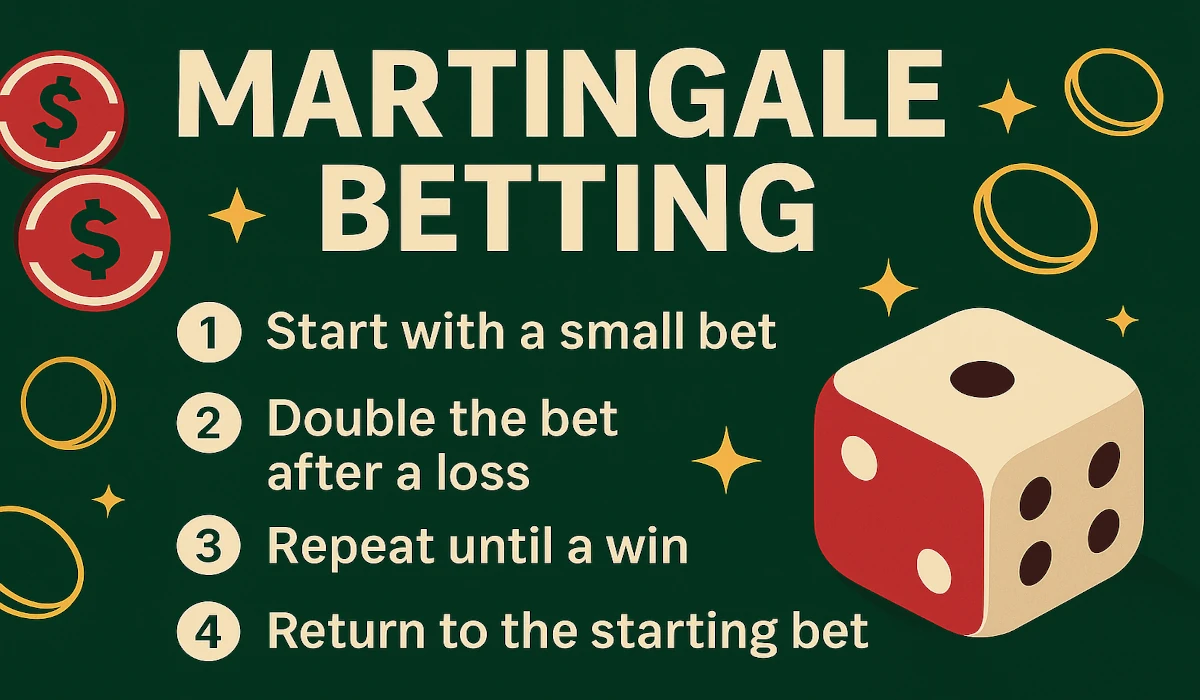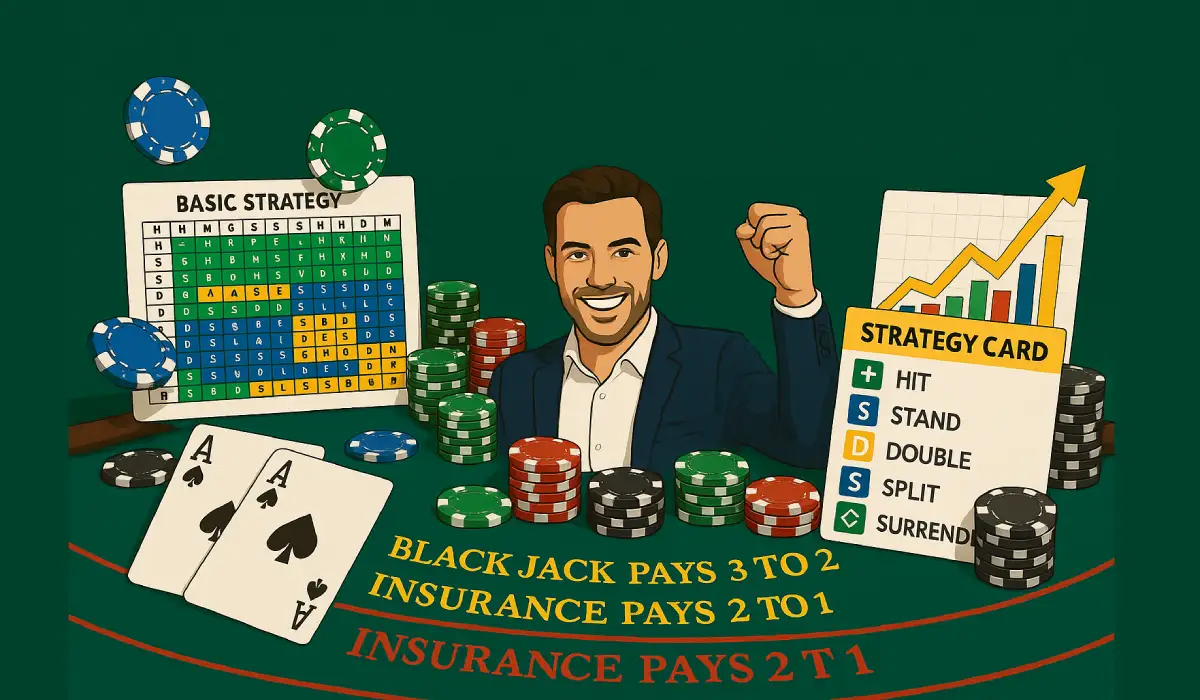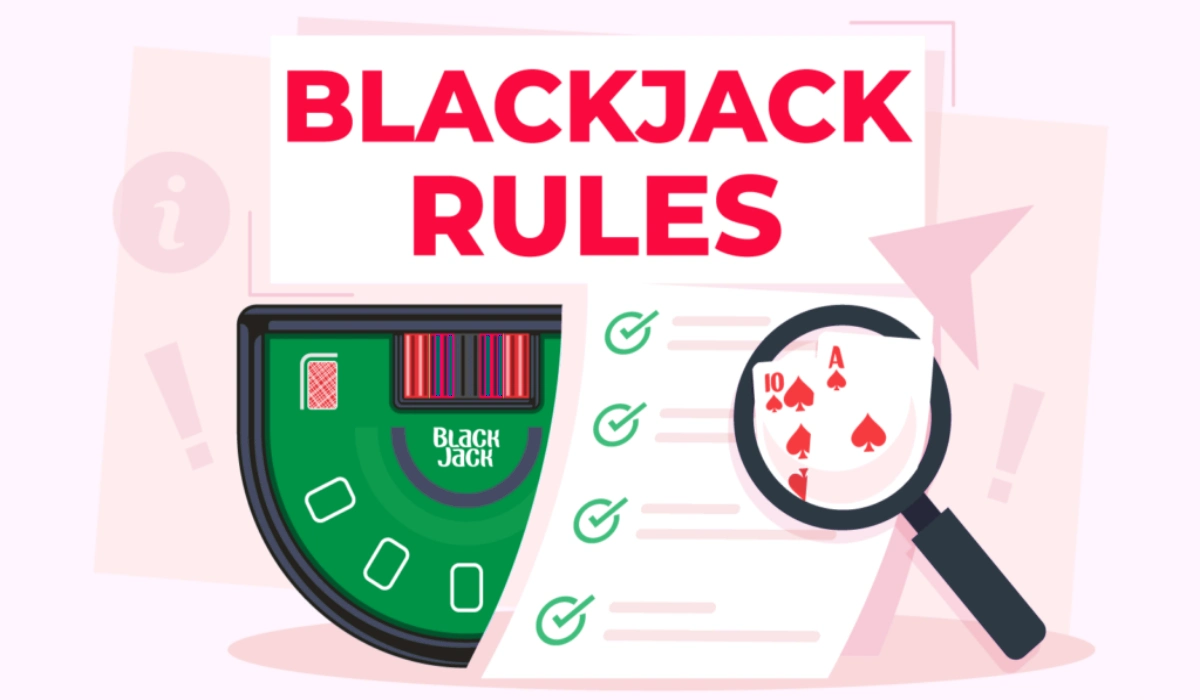
11 Apr 2025
Blackjack Rules - A Comprehensive Guide to Playing Blackjack
🗝️ Key Takeaways
- Blackjack is played to beat the dealer’s hand. Your mission is to get a hand total that’s as close to 21 as you can without going bust. Don’t forget that you’re not playing against other people at the table, you’re playing against the dealer.
- Grasping how cards are valued is straightforward: the numbers on the cards represent their points, face cards are each valued at 10, and the Ace can take on a value of 1 or 11, whichever gives you a better hand.
- On your turn, you may choose to hit, stand, double down, split pairs or surrender. Every decision you make comes with unique advantages and disadvantages that can shape your overall success at the tables.
- The dealer is also -- unlike players -- bound to strict rules, like always hitting with 16 or lower and standing with 17 or higher. Getting a feel for these rules will place you in the right strategic frame of mind.
- Become familiar with the various rule variations, such as American versus European blackjack. From there, customize your techniques to suit the unique casino or table you’re playing at.
- Refer to tools such as basic strategy charts or cheat sheets to help inform your decisions. Learn to practice activities such as card counting safely to develop an advantage among blackjack gameplay.
Rules for playing blackjack are simple enough to make for a fun but challenging experience. The ultimate objective is to achieve a total of 21 without surpassing it, using a regular deck of 52 cards. Each card has its own point value: numbered cards reflect their digits, face cards are assigned a value of 10, and the Ace can act as either 1 or 11, depending on which benefits the hand more.
Players are pitted against the dealer, aiming for a hand that beats their dealer face-up hand. They decide to hit, stand, double down or split their way to victory.
Knowing these basic rules allows players to make more informed decisions while playing, improving their strategy as well as their overall gaming experience. Let’s dig into the nitty-gritty in the coming sections.
🃏 Blackjack: Game Overview
Blackjack is one of the most popular games of chance in America, known for its simple rules and mix of skill and luck. The game has a simple but thrilling objective! Your goal is to outsmart the dealer by creating a hand total that approaches 21 more closely than their own, without going bust.
In this popular casino card game, players try and beat the dealer one-on-one instead of each other. This arrangement provides an extraordinary one-on-one learning experience at each table. To win, you need to beat the dealer’s hand or at least outlast them. Watch out—if you go over 21, you bust and lose.
💥 Objective of Blackjack
The beauty of blackjack comes from the game’s emphasis on numbers and strategic thinking. Your objective is to get to 21, or as close to 21 as you can, without exceeding it. For example, if the first two cards you’re dealt add up to 19, you’re probably going to want to stand.
You’ll be praying the dealer doesn’t pull a better total. Keep in mind, blackjack isn’t a competition against other players, it’s a competition to score the most against the dealer. Since busting automatically ends your turn, balancing risk is essential to taking smart turns. Mastering blackjack strategies can make all the difference between a win and a loss.
🂡 Card Values and Scoring
Learning the value of each card to see how they work together is a must. Cards numbered 2 to 10 hold their corresponding face value. The value of face cards is 10. Cards numbered 2 to 10 hold their corresponding face values. The value of face cards is 10. Aces are 1 or 11 based on what would be best for your hand value.
To get a “blackjack,” or 21 on your first two cards, you need the combination of an Ace and a 10-point card. How you play largely depends on the flexible nature of Aces. For instance, you can play an Ace and 6 as a “soft 17,” which allows you to take action without immediate consequence. This flexibility makes blackjack cards some of the most dynamic in all deck games.
✨ Understanding a Good Hand
Your hand is your best shot at outsmarting the dealer and getting the closest to 21 without going over. Hands that do not have Aces are “hard,” while “soft” hands contain Aces, allowing for greater strategic flexibility.
A soft 18, which is an Ace and a 7, plays differently depending on the dealer’s up card. Take your time to decide whether to hit or stand and develop a strategy.
🎮 How to Play Blackjack: Step-by-Step
Playing blackjack games is all about following a step-by-step procedure that keeps the game moving smoothly. Every step, from placing your first bet blackjack to the result, is an important component to your success.
This is essential knowledge if you want to understand how to play blackjack effectively.
1. Place Your Initial Bet
Choose the amount you want to bet. The game starts with choosing your bet amount. Every table has a minimum bet you’ll need to cover, so make sure your bet is above that amount.
Bets are placed using casino chips, which you’ll exchange for cash at the blackjack table or casino cashier. Manage your bankroll—begin with no more than 5% of your total bankroll so you get the most play per dollar.
For example, if you have a bankroll of $100, at least 20 hands can be played if betting $5 per hand. Your strategy plays an important role - a conservative betting strategy will protect your bankroll, progressive betting uses the power of streaks to your advantage.
2. Receive Your Initial Cards
After all bets are on the table, you are dealt two cards, both face up. The dealer gets two cards: one face up (the upcard) and one face down (the hole card).
Evaluate your hand’s total—an ace and a 10-card equals blackjack, winning 3:2 if the dealer doesn’t match. A hand such as ace-6 is a “soft 17,” allowing some flexibility to take another card or stay.
3. Player’s Turn: Decide Your Move
You must act first, choosing to hit (take another card), stand (keep your current hand), double down (double your bet with one card), or split (separate identical cards into two hands).
Under a particular set of conditions, decisions are based on a simple basic strategy. For example, if the dealer’s upcard is 5, stopping at 12 or higher minimizes risk since the dealer is prone to busting.
🎯 Player Actions Explained
Getting to know the full spectrum of player actions in blackjack is key to making smart decisions on the felt. Each decision you make—hit, stand, double down, split, surrender—impacts your probability of winning and your strategy for the game as a whole.
These actions are more than just instinct. They force you to make strategic decisions based on the cards in your hand, the dealer’s upcard and the rules of blackjack itself.
🃏 Hit: Take Another Card
When you take a hit, you are asking for another card so that you can build your hand value higher. This is a good strategy when your hand is 9 or less. At this stage, you are not at risk of busting.
If you have a soft 18 (A,7) and the dealer is showing a 2-6, you should hit. When you do, you greatly increase your odds of hitting a more winning hand. Hitting is more dangerous as your hand value gets higher and approaches 21.
They shouldn’t be hitting when they have a 12 or more. This is particularly the case when the dealer opens with a weak upcard (a 4, 5 or 6). To indicate a hit, lightly touch the table with your fingertips.
🔥 Stand: End Your Turn
Standing is the action of not taking any additional cards and retaining your current hand total. This is usually the correct move when your hand is good, like 17 or better.
It’s the strategic play when the dealer is showing a weak upcard, because they are more likely to bust. For example, hitting a soft 18 vs dealer’s 9 through Ace will lead to avoidable risk.
To indicate a stand, wave your hand back and forth over your cards.
💸 Double Down: Increase Your Bet
Doubling down allows you the chance to increase your initial bet in return for receiving just one more card. This basic strategy really stands out when your starting hand adds up to 9, 10, or 11.
It’s especially strong when countering a dealer’s weak upcard, like a 4, 5, or 6. If you hold a soft 14 (A,3) and the dealer displays a 2 to 6, you should double your bet.
This simple move greatly increases the amount you stand to earn. Make sure you put your original bet down first before you try to signal a double down by pointing one finger at your cards.
✂️ Split Pairs: Create Two Hands
When you’re given a pair, you can choose to split. This action changes one hand into two separate hands, and you are now able to bet on them independently.
This significantly boosts your rate of success, even on less favorable hands such as 4’s vs a dealer's 5 or 6. You don’t want to be reckless by splitting wildcards like Aces, as you’ll only get one more card on each split hand.
Make an even money bet next to your first bet. Next, make a “peace” sign with your fingers to indicate a divide.
🏳️ Surrender: Forfeit Half Your Bet
Surrendering is actually a realistic course of action when the other side clearly has the advantage. Losing half your stake allows you to lose less in difficult spots.
This is a particularly powerful strategy when you have a bad hand against the dealer’s good upcard. Timing is important, as surrendering is only permitted before doing anything else.
If the dealer is showing a 10 and your hand can’t get much better (7 for 15 or a 12), surrender if possible. Decision-making like this is the key to protecting your bankroll.
🔍 Decoding Dealer's Play
Knowing the dealer’s play rules in blackjack is essential for getting the most out of your blackjack games. These regulations establish guidelines for how dealers should behave while operating the blackjack table games, fostering a stable and reliable environment. By understanding these principles, you can sharpen your approach and improve your decision-making at the table.
🎲 Dealer's Compulsory Actions
Dealers are bound by hard and fast rules, such as hitting on totals of 16 or below and standing on 17 or above. This standardizes the decision across every game and removes it from personal opinion.
For example, if the dealer’s hand is 16, they are required to hit and draw another card. In doing so, you’re increasing your chances of cracking up. Understanding this play helps you anticipate their next steps and play your cards accordingly.
For instance, if the game’s table requires six decks to be used, then you can expect a marginally higher house edge than with two-deck tables. This seemingly minor change might have major implications for how you chose to bet.
⚡️ Dealer Hitting on Soft 17
In addition, at one-third of casinos, dealers must hit on a soft 17. The ace in this hand is valued as 11 but can be counted as seven. This rule is incredibly favorable to the house, as it upsets the balance of increasing the dealer’s chance of strengthening their hand.
Plan your moves with the possibility of a better dealer hand in mind. For example, maintaining on a lower total could be more dangerous in these circumstances.
🕹️ Impact of Dealer Rules on Strategy
Dealer rules dictate how you plan to play your hand. A dealer with a ten underneath can indicate a potential blackjack, which can clear the table.
Be sure to know precise rules from each casino to know what gives you the best chance. Understanding of differences, such as even money payouts, makes for a more informed player and gaming experience.
⚖️ Key Blackjack Rules and Nuances
Knowing the basic rules of blackjack and the nuances of the game is essential to becoming a better player at the blackjack table games. By identifying advantageous hand values and strategic opportunities, such as side bets, you can push the limit and enhance your chances of winning in this popular game.
🌟 Naturals: Blackjack Explained
A natural blackjack is when all the cards you start off with add up to 21, most often an ace and a 10-value card. This is the strongest hand and is paid out at a ratio of 3:2 in most games, making it more rewarding than other wins.
For example, with a $10 bet, a natural blackjack would pay you $15 as opposed to the even-money payout it would normally be. Understanding the worth of this hand changes your betting approach. Naturals usually recommend this because they want liability to come out on the safe side with conservative plays.
When players choose instant payouts, they can minimize their risk.
🛡️ Insurance Bets: A Risky Proposition
Insurance bets are available any time the dealer’s upcard is an ace. Similar to the insurance side bet, this side bet protects you against a dealer natural blackjack. While the payout is 2:1, the odds rarely favor the player.
For instance, in a six-deck game, the dealer’s probability of making a blackjack is around 31%. Insurance should be taken based on the dealer’s upcard and your knowledge of the deck at large.
🃏 Reshuffling: When and Why
Reshuffling usually happens once a predetermined number of cards have been dealt, throwing off card counting and forcing changes in strategy. Be on the lookout for reshuffling opportunities, particularly in six-deck games.
They reset the card flow and force you to adjust your strategy on the fly.
🚦 Signaling Your Intentions Clearly
Sound off with hand signals for game environment. Tapping the felt to hit or waving for a stand prevents one of the common miscommunication issues from occurring.
Since ignorance helps you make mistakes, get to know these signals so you can keep the confidence of the table on your side.
🎯 Mastering Blackjack Strategy
Becoming skilled at blackjack requires a methodical and disciplined approach that includes education, practice, and willingness to adjust. Learn all the basic strategies to maximize your win rate. This strategy is one of the first steps towards taking the house edge down below 0.5%!
Here’s a closer look at the key elements that comprise a successful blackjack strategy.
⚒️ Basic Strategy: The Foundation
The foundational element to blackjack is basic strategy, a crucial component to successful gameplay. This smart strategy is about maximizing your wins by making the best smart moves for every possible combination of your hand.
It factors in the dealer’s upcard. It’s always a good strategy to split a pair of 8s to make two separate hands. This strategy does greatly increase your odds as opposed to playing a hard 16.
An Ace paired with a 6 creates a soft 17, offering greater flexibility in how you play your hand. If instead you hit and draw a 5, the ace’s value changes to 1, resulting in a hard 12. By championing these principles, you build a strong base for more sophisticated strategies.
📝 Blackjack Cheat Sheet: Your Quick Guide
A blackjack cheat sheet is a simple but powerful tool for making the right call every time. It simplifies essential strategies into an easy to read chart format, displaying helpful icons indicating what to do such as hit, stand, split or double down.
For example, when you have a pair of 7’s, split those or play them as a hard 14 based on the dealer’s card. Make this guide your go-to resource for making smart, strategic decisions at the blackjack table.
✨ Memorizing Strategy Charts Effectively
One way to make it easier to memorize is by breaking strategy charts into sections. Concentrate on one section first – say, soft totals – before advancing to hard totals.
A consistent practice routine whether it’s flashcards or an app makes sure these strategies come as naturally as breathing.
🧩 Adapting to Different Rule Variations
Casino rules, like blackjack payouts (e.g., 3:2) or doubling options, can vary. Change your strategy to stay on top of the best long-term strategy.
Make sure you’re reaping the most benefits from positive conditions.
💥 Advanced Blackjack Tactics
To get ahead of all those blackjack players, learning advanced tactics will help you play smarter and even turn the tables on the house. Mastering basic strategy is key.
Learning more difficult strategies such as card counting and shuffle tracking will hone your skills and set you apart from the competition. These strategies take practice, patience, and a deep understanding of the game’s dynamics.
🔢 Card Counting Basics
Card counting isn’t just a scam tactic—it’s an effective strategy for keeping track of the proportion of high versus low cards left in the deck. By assigning values to cards—typically +1 for low cards (2–6), -1 for high cards (10–Ace), and 0 for others—you can estimate when the deck favors the player.
A positive count means more high cards are left in the deck. This increases your odds of getting a blackjack or improving your hand substantially! The Hi-Lo system is the easiest and most effective counting methods for beginners.
Conversely, if the running count exceeds +5, the odds are in your favor. That means you have opportunities to raise your bets with more clever precision. Unfortunately, card counting isn’t that simple, and it requires years of discipline and real-game experience to perfect.
🚀 Shuffle Tracking Awareness
Shuffle tracking is the practice of watching the dealer shuffle the cards to determine where the cards will land in the deck. By learning to spot shuffling patterns, you’ll be able to keep tabs on clusters of higher-value cards and increase your bet size when the time is right.
When you combine shuffle tracking with card counting, you vastly increase your knowledge of the deck’s composition. It’s a slightly more advanced but effective tactic that fits right into your strategy as a whole.
🌟 Recognizing Advantageous Situations
Savvy players know when to change course, siding with the dealer’s upcard, table rules, and other players’ decisions. For example, taking advantage of a good count to double down or standing up to the dealer’s bust card can help players achieve their highest possible wins.
Reading the table environment helps you maximize your rewards by maximizing your actionable and advantageous situations.
🎮 Blackjack Variations and Their Impact
Blackjack comes in various forms, including popular blackjack variants, and understanding these variations is essential for optimizing your gameplay. Each blackjack game features different rules that can affect your tactics and, most importantly, your expected returns. By simply educating yourself on these blackjack tables, you are already setting yourself up to have the best possible experience at the table.
🌍 American vs. European Blackjack
American and European blackjack are two of the most common variants, but the two games differ in important ways that dramatically impact gameplay. In American blackjack, the dealer receives two cards at the start—one face up and one face down (the hole card). If the dealer’s upcard is an Ace, they check for blackjack right away.
This rule has a large effect on optimal strategy because you are able to predict the dealer’s possible hand at an earlier stage. In European blackjack, the dealer does not take a second card immediately. This leads to situations in which players need to take actions without complete information about the dealer, needing to play more conservatively.
European blackjack usually plays with fewer decks, which reduces the house advantage. Some rules, like not allowing surrender, can greatly reduce this advantage.
🎲 Rule Differences Across Casinos
Casino-specific rules can make a huge difference in your blackjack experience too. For instance, some tables offer a 6:5 payout for blackjack rather than the usual 3:2, increasing the house edge. Other variations are prohibitions on doubling down or splitting pairs.
Always check the posted table rules, as even small variations can change your strategy and bet placement to your advantage or detriment.
⚖️ Adjusting Strategy for Specific Rules
Adapting your game plan to match the specific rules is every bit as important. A strategy chart can help you make the best decision in any particular situation whether it’s hitting, standing, or splitting.
Single-deck blackjack, to take one example, has a house edge as low as 0.48%, thus offering optimal players the best long-term returns. Being able to stay adaptable will help you make the best play no matter what variant you are playing.
🔒 Conclusion
Playing blackjack successfully comes down to knowing the rules of the game, making the right decisions, and playing with discipline. Each choice you take at the blackjack table counts big. Understanding when to hit, stand, split or double down is crucial in making the most out of your blackjack gameplay. The game isn’t simply a luck-based casino game—it takes confidence and real strategy.
You can play it safe, or raise the stakes by learning more advanced strategies. Blackjack is rife with unrealized chances to hone your craft! Every new variation adds a new angle, making every new experience surprising and fun. Make time to familiarize yourself, practice, and have fun with it.
If you’re looking to take your expertise to the next level, take a seat at the policymaker table and take action. Blackjack is out there— good luck, play safe and enjoy!
Frequently Asked Questions❓
What is the main objective of blackjack?
The goal of blackjack is to beat the dealer by having a hand value closer to 21 without exceeding it. You win by having a higher total than the dealer or when the dealer busts, making it a popular game in casino table games.
How many decks are used in blackjack?
It’s common practice for casinos to employ 6 to 8 decks in a blackjack shoe to deter classic card counting, while single deck blackjack games and double-deck variations are available, usually with somewhat different rules.
What does it mean to "stand" in blackjack?
To “stand” in blackjack games is to let the dealer know you’re satisfied with your player hand and don’t want any more cards. This usually comes into play when you’re near 21 or when the dealer is showing a weak hand.
When should I "double down"?
When your first two cards add up to 9, 10, or 11, and the dealer is showing a bust card (4, 5, 6), this strategy gives you the chance to double your bet blackjack for one extra card.
What happens if both the player and dealer have the same hand value?
If the player blackjack and dealer tie, the round is considered a "push," resulting in no winner or payout. In this case, your bet blackjack is refunded, ensuring neither side wins, so you don’t lose money either.
Can the dealer make decisions in blackjack?
No, the dealer in blackjack table games has to follow very specific rules. They are required to hit until their hand reaches a minimum of 17 and stand on 17 or more, as is standard in many casinos.
What is a "blackjack"?
A 'blackjack' is when you receive an Ace and a 10-value card (10, Jack, Queen, or King) in your initial two cards, resulting in a natural win unless the dealer blackjack also has one.
